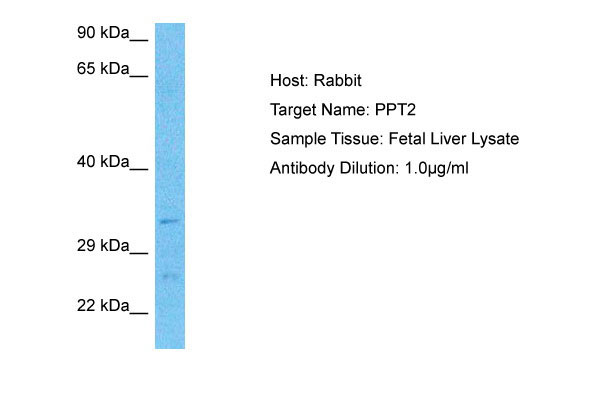PPT2 Antibody - C-terminal region
Rabbit Polyclonal Antibody
- SPECIFICATION
- CITATIONS
- PROTOCOLS
- BACKGROUND

Application
| WB |
|---|---|
| Primary Accession | Q9UMR5 |
| Reactivity | Human |
| Host | Rabbit |
| Clonality | Polyclonal |
| Calculated MW | 33kDa |
| Gene ID | 9374 |
|---|---|
| Alias Symbol | PPT2, |
| Other Names | Lysosomal thioesterase PPT2, PPT-2, 3.1.2.-, S-thioesterase G14, PPT2 |
| Format | Liquid. Purified antibody supplied in 1x PBS buffer with 0.09% (w/v) sodium azide and 2% sucrose. |
| Reconstitution & Storage | Add 50 &mu, l of distilled water. Final Anti-PPT2 antibody concentration is 1 mg/ml in PBS buffer with 2% sucrose. For longer periods of storage, store at -20°C. Avoid repeat freeze-thaw cycles. |
| Precautions | PPT2 Antibody - C-terminal region is for research use only and not for use in diagnostic or therapeutic procedures. |
| Name | PPT2 (HGNC:9326) |
|---|---|
| Function | Catalyzes the cleavage of thioester bonds from S-palmitoyl- CoA or S-palmitoyl-N-acetylcysteamine (unbranched structures) but does not have activity against palmitoylcysteine or palmitoylated proteins, branched structures or bulky head groups. Conversely, hydrolyzes both long and short chain fatty acyl-CoA substrate. |
| Cellular Location | Lysosome. |
| Tissue Location | Broadly expressed, with highest levels in skeletal muscle. |

Thousands of laboratories across the world have published research that depended on the performance of antibodies from Abcepta to advance their research. Check out links to articles that cite our products in major peer-reviewed journals, organized by research category.
info@abcepta.com, and receive a free "I Love Antibodies" mug.
Provided below are standard protocols that you may find useful for product applications.
Background
Removes thioester-linked fatty acyl groups from various substrates including S-palmitoyl-CoA. Has the highest S- thioesterase activity for the acyl groups palmitic and myristic acid followed by other short- and long-chain acyl substrates. However, because of structural constraints, is unable to remove palmitate from peptides or proteins.
References
Soyombo A.A.,et al.J. Biol. Chem. 272:27456-27463(1997).
Aguado B.,et al.Biochem. J. 341:679-689(1999).
Wiemann S.,et al.Genome Res. 11:422-435(2001).
Ebert L.,et al.Submitted (JUN-2004) to the EMBL/GenBank/DDBJ databases.
Ota T.,et al.Nat. Genet. 36:40-45(2004).
If you have used an Abcepta product and would like to share how it has performed, please click on the "Submit Review" button and provide the requested information. Our staff will examine and post your review and contact you if needed.
If you have any additional inquiries please email technical services at tech@abcepta.com.













 Foundational characteristics of cancer include proliferation, angiogenesis, migration, evasion of apoptosis, and cellular immortality. Find key markers for these cellular processes and antibodies to detect them.
Foundational characteristics of cancer include proliferation, angiogenesis, migration, evasion of apoptosis, and cellular immortality. Find key markers for these cellular processes and antibodies to detect them. The SUMOplot™ Analysis Program predicts and scores sumoylation sites in your protein. SUMOylation is a post-translational modification involved in various cellular processes, such as nuclear-cytosolic transport, transcriptional regulation, apoptosis, protein stability, response to stress, and progression through the cell cycle.
The SUMOplot™ Analysis Program predicts and scores sumoylation sites in your protein. SUMOylation is a post-translational modification involved in various cellular processes, such as nuclear-cytosolic transport, transcriptional regulation, apoptosis, protein stability, response to stress, and progression through the cell cycle. The Autophagy Receptor Motif Plotter predicts and scores autophagy receptor binding sites in your protein. Identifying proteins connected to this pathway is critical to understanding the role of autophagy in physiological as well as pathological processes such as development, differentiation, neurodegenerative diseases, stress, infection, and cancer.
The Autophagy Receptor Motif Plotter predicts and scores autophagy receptor binding sites in your protein. Identifying proteins connected to this pathway is critical to understanding the role of autophagy in physiological as well as pathological processes such as development, differentiation, neurodegenerative diseases, stress, infection, and cancer.


